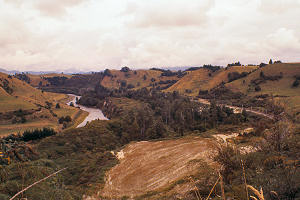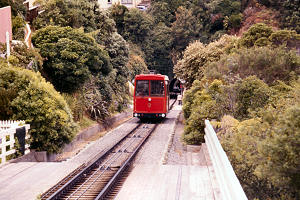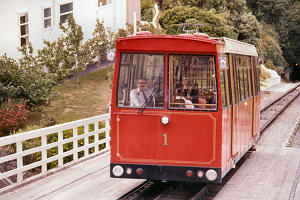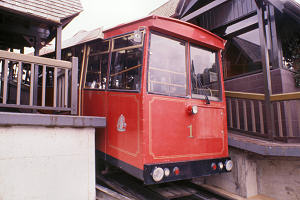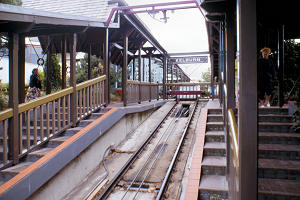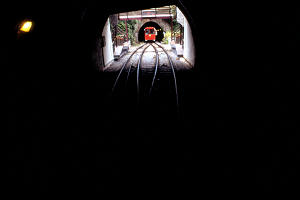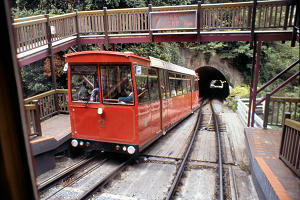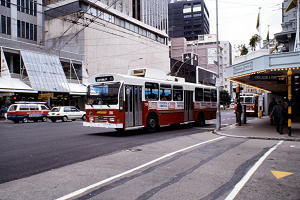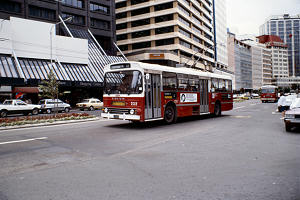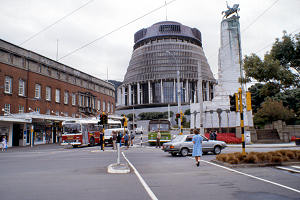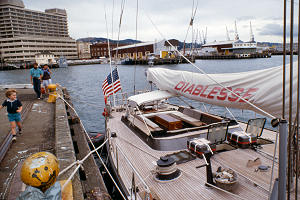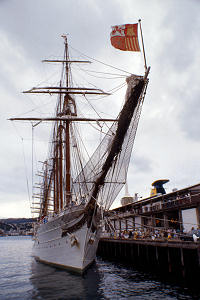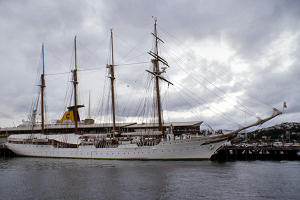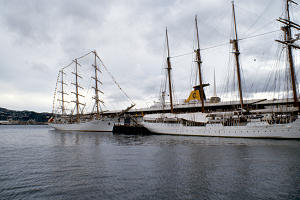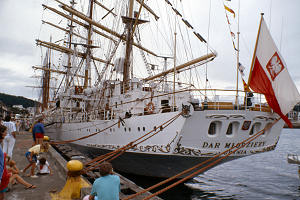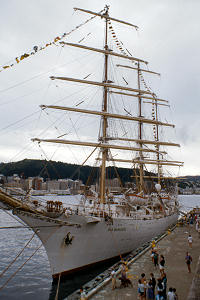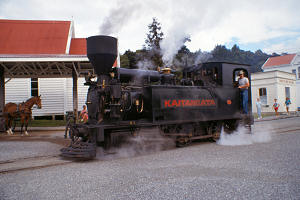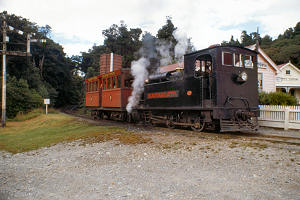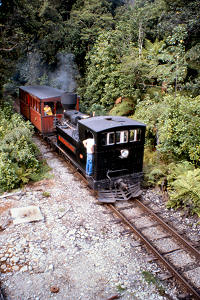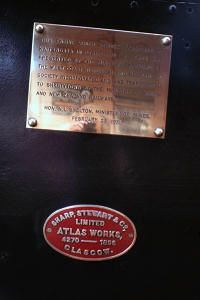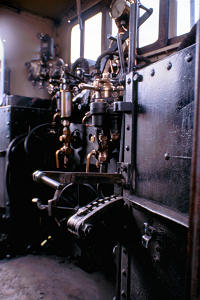New Zealand 1988
Thursday 4 February — Auckland to Palmerston North (535km)
Well, at last, I’ve started. It did not take long this morning to transfer the remnant of my
domesticity from the flat to the boot of the car, return the keys (of the flat) to the landlord and set
off into the Great New Zealand Adventure.
The weather was overcast but dry as I turned onto the Southern Motorway and headed south from Auckland.
Just north of Huntly, I passed the scene of an accident, one mangled car by the roadside, a pile of
scrap in a nearby field and two ambulances. A mile or two further south, there was a fire engine
speeding north. An encouragement to drive carefully.
Anyway, on to Hamilton, turn right for Te Awamutu, Te Kuiti and Taumarunui.
The rain started north of Te Awamutu but eased off just before Taumarunui where I managed to get
back and forth to a tearoom for lunch without getting wet. I stopped again a few miles south of the town
to photograph the North Island Main Trunk railway where it shares a gorge with the upper reaches of the
Wanganui River.
It was not long before the rain returned, becoming torrential by the time I reached Ohakune. I was
relieved to spot a filling station with a covered forecourt where, after fording the gutter, I was able
to get petrol without getting wet, by dint of parking on the wrong side of the pumps for better shelter
and dragging the hose across the top of the car.
Continued through Waiouru (without stopping at the Army Museum) and Taihape (famous for its pies) before
turning left onto PH54 at Mangaweka, for Fielding and Palmerston North. There is an excellent view of
the Rangitikei viaduct just after the junction. The first ten kilometres of this road is unsealed and
sticks to the side of a rather spectacular gorge. The rain by this time was not heavy, just persistent,
with low cloud on the hilltops and a lot of mist so what should have been a scenic run through the
ranges was a bit grey.
In time, I reached Palmerston North, found the Youth Hostel and booked in for the night. This is a
student hostel for most of the year and I’ve got what is obviously a study bedroom, all to myself.
It took me some time to find the necessary bits and pieces amongst all the junk in the boot, especially
as I didn’t want to unload too much in the rain. It will be necessary to refine my packing
strategy substantially. As it is, I couldn’t find my trousers.
The rain having eased to a mere drizzle, I ventured forth to sample the exotic night life of Palmerston
North. At nine in the evening, the main square was deserted and Macdonalds had only half a dozen
customers. I resisted the temptation to enter the only bar
I saw - a Cobb & Co - as it looked a bit up-market for my scruffy attire, which says more about my
attire than it does about Cobb & Co. Returned to the hostel and to bed.
Friday 5 February — Palmerston North to Wellington (179km)
I awoke late (i.e. after seven o’clock), showered and went outside to consider the weather. The
rain was well off and the cloud had a character that suggested it would soon break up. There was time
for a quick breakfast before vacuumming the lounge and hall as my first YH chore in a long time, and
departed Palmerston North for Wellington.
Now, there are two ways of heading south from Palmerston North to Levin, a direct route along the
foothills of the Tararua Range via Shannon or a much longer route across country to pick up SH1 north of
Foxton. As I saw no signs for Shannon so followed those for Levin. I realised the error of my ways (no
pun intended) when the road turned away from the hills, but each time I was inclined to check the map, I
would see another sign for Levin and carry on, until I found myself at SH1 north of Foxton. In a fit of
pique, I crossed straight over and went to see the sea at Himatangi Beach before continuing south.
On arrival in Wellington, I had a short tour around the city centre before driving up and down the
Terrace a couple of times to locate ICL House. Having achieved that, I turned my attention to the
parking problem. I’ve never had to park in Wellington on a weekday before and everything looked
chaotic. There was a short length of double yellow line adjacent to ICL house so I decided to park
there, leap into the office and take advice. No sooner had I pulled in, stopped the engine and removed
my glasses, a female person climbed into the car immediately in front of me and removed it from a
parking meter. I moved forward one car length and acquired a meter with one hour and fifty minutes on
the clock. Into the building, dug up Terry Brookes, met a few folk, had a cup of tea, checked that my
affairs were in order and went out again to move the car to the recommended car park. There was still
one hour and fifty minutes on the clock. A brief swither, but I decided to move it anyway.
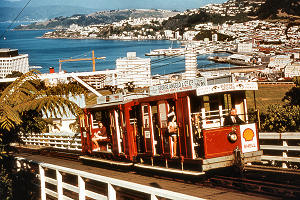
|
(As was, slide bought in 1979)
|
Not much of a wait to get into the car park, the ticket was timed half an hour ahead and I found a space
first time round. Took my camera and Swannie (the cloud was thickening and the wind getting a bit cool)
and returned to ICL to go to the Oxford for lunch with the lads, three pints and two cheese rolls. Back
at ICL, I picked up my IR12 and said goodbye.
I took the Cable Car up to Kelburn to take some photos, then descended to Lambton Quay to photograph
trolley buses, the only ones still operating in New Zealand.
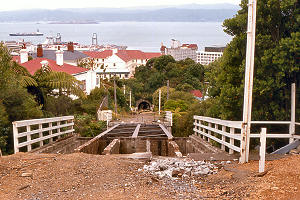
|
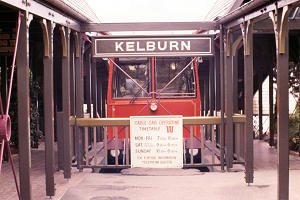
|
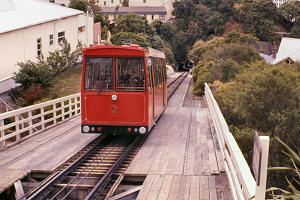
|
(Kelburn Cable Car - 1979)
|
|
|
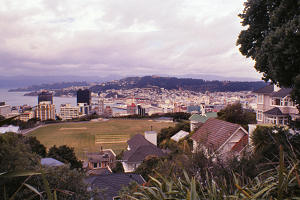
|
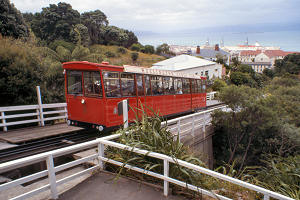
|
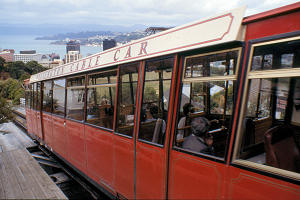
|
Wellington beyond Kelburn Cricket Club
|
|
|
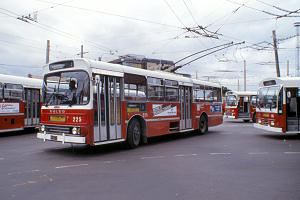
|
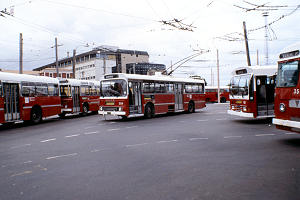
|
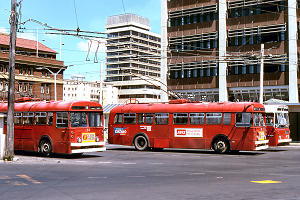
|
Railway Station terminus
|
(1979) |
Returned to the car and departed the car park four hours and twenty-nine minutes after entering it but,
because of the wrong time on the ticket, I paid for just the four hours, and went in search of Karori.
The latest McGee residence presents a pleasing aspect to the eye of the beholder, being a white walled
wooden bungalow with a wide red-tiled recessed porch, the whole surmounted by a faded red tin roof and
surrounded by a pleasant grassed enclosure attractively ornamented with small trees and shrubs. Inside,
some rooms have been adapted to the taste of the family, and very tasteful it is too, others still
remain as was, while the enlarged kitchen is at the moment being renovated. The family were all well,
Hannah attending kindergarten and William about to start school.
Saturday 6 February — Wellington (Waitangi Day)
Wet, windy, Wellington. Southerly, squally, sh***y. Lay in bed till after eight, listening to the rain,
then Hannah and William came in and that was that. A morning en famille, until Anne went off to work
about two o’clock and couldn’t find the Mini. She returned to the house to ask Dave where he
had left it, but he had left it outside the gate just in front of my Mazda, where now there was an empty
space.
The family car, a Merc, being off the road at that time with a couple of teeth missing from second gear,
the Mini was, or had been, the only transport. I took Anne to work while Dave phoned the police, who
arrived reasonably soon and took the details. The theory was that it was taken by late night revellers
on their way home who probably free-wheeled it some distance down the hill before starting the engine.
Dave took the Mazda and cruised around a bit keeping his eyes open, but to no avail.
That night I wrapped Leo’s anchor chain around my steering wheel and pedals and fastened it with a
large padlock.
Sunday 7 February — Wellington
The weather was a complete contrast to Saturday, being fine and dry with the gentlest of zephyrs to stir
the air. I walked down to the neighbourhood dairy and bought the Auckland Sunday Star! Took a trip down
to the railway station and attempted to book a crossing to Picton for the morrow but the first space
available was on Tuesday afternoon. It would probably be OK if I turned up on spec on Monday, but I
decided just to stay the extra day in Wellington. It was a quiet, pleasant morning, some visitors
arrived and I got the impression that had I been looking for employment, I might have met someone
useful.
Then the phone rang. The police. The Mini had been found on a quiet road on the other side of
Johnsonville, in a ditch, against a fence, one broken window, no stereo or steering wheel. (It had been
a sports steering wheel.) So, Dave gathered a toolbox, tow-rope, steering wheel and a gallon of petrol
and off we went. The road, in which the police had said the car was, seemed a bit disjointed but we
managed to follow it and found the car without too much trouble.
A sorry sight. It’s amazing how much broken glass can come from one window. The bonnet was loose,
the roof stove in as if the car had been rolled, one side flattened against a fencepost, a few loose
wires where the stereo had been, footprints on the inside of the roof, no water in the radiator, no
petrol in the tank. It wasn’t actually in a ditch, rather it was perched on the brink of a steep
slope with only the fence between it and a fifty foot descent into a paddock.
We decided to tow the car back onto the flat and in so doing, did a bit more damage to the paintwork with
an unkindly placed staple in the fencepost. One tyre was flat so we changed the wheel, put water in the
radiator, petrol in the tank and the engine started after just a few turns. Dave drove it home, stopping
only a couple of times to top up the water (from a convenient hose with which a young lad was watering
his garden) and retie the bonnet.
So, having got that over, we set about what was to have been the main activity of the day and went down
to see the two tall ships at the Overseas Passenger Terminal. They were open to the public from 1-5pm.
We arrived at one minute past five. Beautiful ships, one Spanish, one Polish, on their way home from the
Australian Bicentennial celebrations. There was a cruise liner at the other side of the wharf.
On the way back to the car, we watched a rat trying to eat someone’s discarded dinner, but it was
having some difficulty as it had to scurry for cover whenever someone came along. We went to Macdonalds
for tea, I don’t think I’ll make a habit of it. Back at Karori, we cleared the broken glass
out of the Mini, washed both cars and hid them over the brow of the hill.
Monday 8 February — Wellington
The weather was certainly changeable. No wind, but wet, so my plan to spend the day sightseeing around
Wellington lost much of its attraction, especially the harbour cruise. So, I spent much of the afternoon
scraping paper of the kitchen floor. At least I was useful.
Tuesday 9 February — Wellington to Picton (53km)
And the weather changed again, giving a warm and sunny morning. I left Karori about half past two and
drove down to the ferry terminal, boarding the Arahura about quarter past three. By the time we left,
more or less on time at four o’clock, the car deck was full with some extras on the train deck,
but the passenger accommodation was far from full.
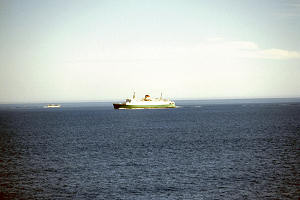
|
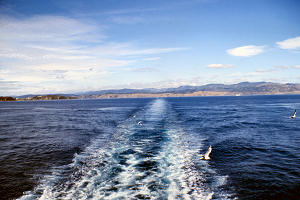
|
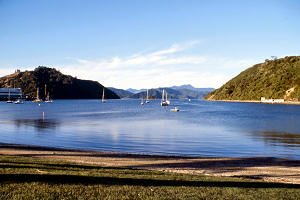
|
Aratika
|
Leaving Port Nicholson |
Evening on Picton Harbour |
After a calm crossing, we entered the Tory Channel about six o’clock and were berthed in Picton by
quarter past seven. One disadvantage of having a car was that I had to descend to the car deck before we
docked and was unable to observe the manoeuvring involved.
I had a bit of a wander around the town and a couple of pints of Monteiths before leaving town on the
Blenheim road. I found a secluded rest area about ten kilometres south of town, at about quarter to
nine, and decided to stop for the night.
Shortly after leaving Wellington, I had realised that I’d left my good trousers, no, make that
better trousers and shirt, and my planned itinerary and Australian timetables at Dave’s. Ah well,
I’d just have to manage without.
Wednesday 10 February — Picton to Murchison (317km)
One scare during the night. A couple of campervans came past about half past ten, noisy things, but
luckily they did not stop. It’s not that I mind company, just that I prefer my own.
The morning dawned a bit cloudy but still dry. I got going about six thirty and drove on to Blenheim. I
quickly spotted a tearoom that was open and had breakfast.
There was the occasional glimpse of the sun as I drove inland up the Wairau Valley but I was heading
towards low cloud and mist. A few patches of drizzle as the road climbed towards Tophouse Saddle. When I
got to the top, the weather looked much brighter towards Nelson, but my course was set west, and there I
went, stopping at Lake Rotoiti (St Arnaud) for a look around. There is a seismograph in the Visitor
Centre but no earthquakes.
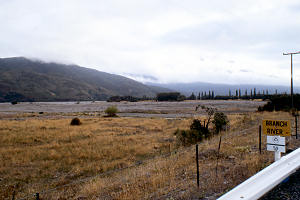
|
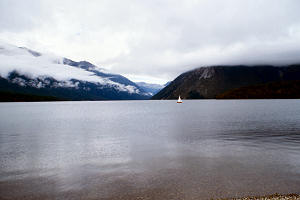
|
Wairau Valley
|
Lake Rotoiti |
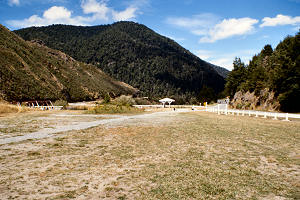
|
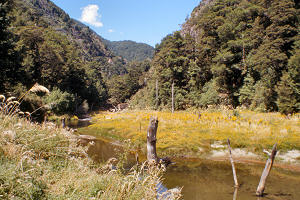
|
Kawatiri Junction
|
River Hope |
Continued on to Kawatiri Junction, once the end of a line from Nelson which was originally planned to go
right through to the west coast at Westport. Passenger services never got much further than Glenhope and
became something of a cause celebre when they were finally withdrawn in 1955. The station yard at
Kawatiri is now a rest area, with a short walk through an old railway tunnel. The River Hope flows into
the Buller at this point.
On to Murchison, arriving in time for lunch in a pub, The Hampden Hotel. The best broth I’ve tasted
in a long time. The beer wasn’t bad either. I couldn’t make up my mind whether to stop over
in Murchison, in the YH, or to go on towards Westport so I decided to procrastinate by taking the scenic
drive over the Maruia Saddle.
Going in that direction, I reached the Six Mile Walkway, six miles from Murchison. This is a forest walk
around the waterworks of an early small scale hydroelectric scheme. I looked at the information board
and decided to give it a go, as it said one to one and a half hours, and I had time to spare. When I got
to the further end, there was an extra bit to the Six Mile Lakes, so I decided to look at them as well.
Small, in a pleasant valley. Ended up spending two hours on a very pleasant walk with occasional items
of interest with little notices explaining what was what. Had a look at the generator, now maintained by
the local historical society.
I continued on the road to the Maruia Saddle, passing a sign warning that the road was not suitable for
caravans. It should have warned that it was not suitable for Japanese hatchbacks! Got quite a shaking on
the rough road, and it wasn’t very scenic as most of the time the forest blocked any view.
By this time I had decided to spend the night in Murchison so I headed back towards town, stopping at the
Maruia Falls, created in the great Murchison Earthquake of 1929.
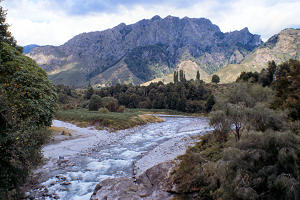
|
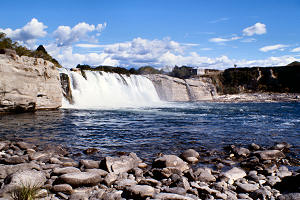
|
A mountain above the Matakitaki River
|
Maruia Falls |
The hostel is a hall, hardboard partitions dividing off the sleeping quarters. Booked in, picked a bunk,
showered and headed out to hit the town. Had a couple of pints in each of the two pubs in Murchison
before returning to the hostel to write this and retire.
Thursday 11 February — Murchison to Greymouth (280km)
Now, last night the warden person asked if I was wanting to leave before eight o’clock as that was
when she, being non-resident, turned up for work. I said probably, so she returned my card on the spot.
So I got away at twenty past seven without any chores, he he, and no breakfast. I still haven’t
got the feeding bit sorted out.
Stopped a bit down the road at a fairly scenic spot and ate an apple. Continued down to Inangahua and
pulled into a filling station. No petrol. I hadn’t run out but was getting a bit low. Dilemma!
Reefton was nearer but I wanted to go to Westport so I decided to live dangerously and headed off down
the Buller Gorge. No problem. When I got to Westport, the tank took only thirty-two and a bit litres, so
I must have had about seven litres to spare. I must have been getting over thirteen kilometres to the
litre, a good bit more than around Auckland.
Anyway, I headed off to Denniston, an abandoned mining community famous for its “incline”.
This was an arrangement for lowering coal wagons down the side of the plateau, 1700’ at angles
between 35 and 47 degrees, with the empties going up as a counterweight. I decided against walking up
the incline or the restored bridle path which was for a great many years the only access to the top, and
I drove up the road which was completed only a few years before the mine closed in 1964.
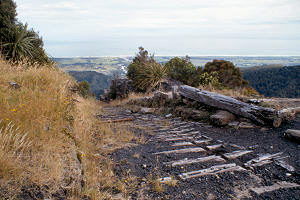
|
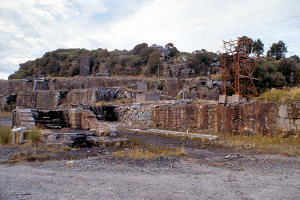
|
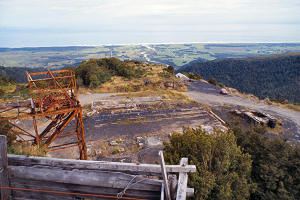
|
Top of the Incline
|
End of the aerial tramway |
Looking down 1700 feet |
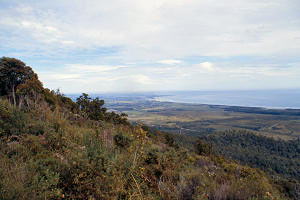
|
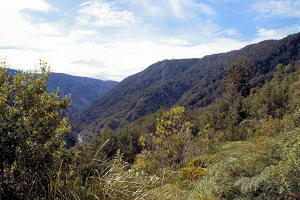
|
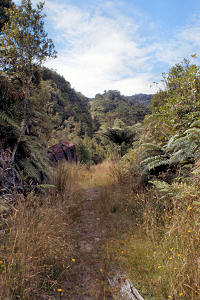
|
South towards Westport
|
The scar marks the route |
Looking up the Incline |
After a short wander amongst the rusting relics, and a few photos, I returned to Westport for a late
lunch, a wander around the town and a withdrawal from the bank. On the way out of town, I spotted a sign
for Coaltown and visited the small mining museum with a section on West Coast gold mining, some pioneer
relics as well as a good collection of coal mining memorabilia and much information on the incline (the
only outstanding thing about West Coast coal apart from its steaming qualities). There is a book on the
incline, aptly entitled "Coal from the Clouds" but it was currently out of print so I bought a
T-shirt instead.
I drove down the coast without incident or interest (apart from the scenery) to the Pancake Rocks (so
called because of the stratified, columnar nature of the eroded rock, like piles of pancakes), at
Punakaiki where I wandered around, broiling in the sun, for a bit. The tide was not high and the swell
was negligible so the blowholes were not doing much, only one let out the occasional feeble gasp.
Enjoyed a reasonable lunch at the cafe there, no, it was afternoon tea by this time, and then drove on
to Greymouth.
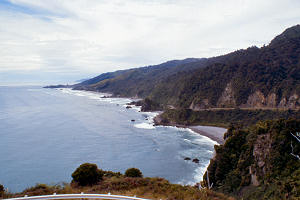
|
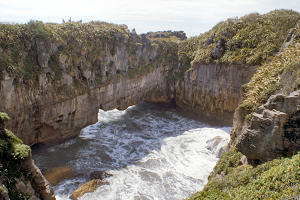
|
The coast south of Westport
|
Natural arch at Punakaiki |
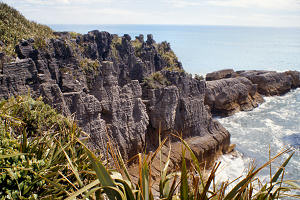
|
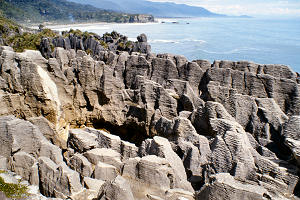
|
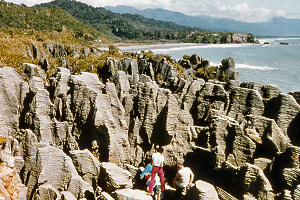
|
Pancake Rocks at Punakaiki
|
(I bought this slide in 1979) |
When I booked into the hostel, I was informed that there were already two lads from Edinburgh there but I
didn’t meet them. Went downtown for a beer or two and got lost on the way back to the hostel, on
the wrong side of the drain, and got caught in the rain. In the end, I found the hostel and retired.
Friday 12 February — Greymouth to Okarito (239km)
Up, washed, fed and ready to go when the warden opened the office at eight o’clock. I swept the
dorm and went down to look at the sea (flat calm) before setting off for Rutherglen (six houses spread
along the road) and Shantytown where an early twentieth century theme park has been developed. The steam
train is hauled by Kaitangata, built in 1896 by Sharp, Stewart & Co, Atlas Works, Glasgow, which
spent most of its working life hauling logs out of the forest. Amongst the other exhibits, I came across
a wooden refrigerator which also had been made in Glasgow. I resisted the temptation to spend $4 for a
go at gold panning, keep what you find, and went for elevenses in the licensed tearoom, though I
didn’t take advantage of the licence.
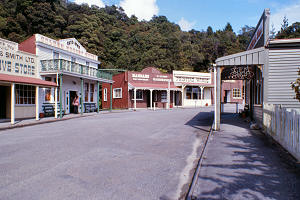
|
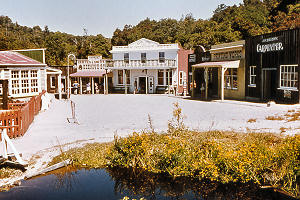
|
Main Street, Shantytown
|
(One I bought in 1979) |
During this time I had realised that I’d left my juice bottle at the hostel so I had to nip back to
Greymouth to retrieve it, before continuing south to Hokitika. A look around the town, a bit of
shopping, a visit to the Westland Museum where they have an audio-visual presentation and artefacts on
the West Coast gold rushes and a mention of the coal mining to the north. They also have a working model
of a gold mining dredge as used on Westland rivers in the early past of this century, made out of 35,000
bits of Meccano.
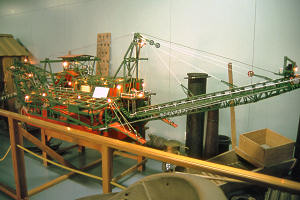
|
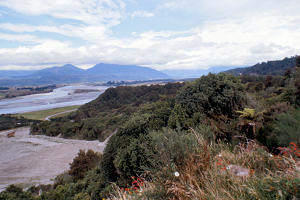
|
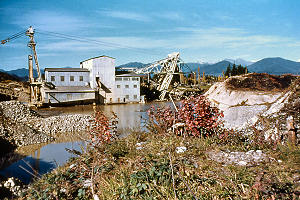
|
(Photographed in 1998)
|
Hokitika River from near Kaniere |
(Kaniere gold dredge, bought in 1979) |
On to Ross, once a gold mining town. I called into the Visitor Centre and decided to stroll round one of
the two walks through the old workings. Turned my ankle (again) but it wasn’t bad and when I
passed the end of the second track, I decided to go round that as well. In the end, about ninety minutes
walk.
And on south again. I bought fish and chips in Harihari, not very good, I’ve been spoilt by the
quality of my local chip shop in Remuera (Upland Road), but I found a nice spot to sit and eat them.
Stopped just south of Whataroa for a couple of hitch-hikers, Israeli lasses who had been in Greymouth
last night. They had had a poor day of it so I took them down to Franz Joseph, even though it was a few
miles further than Okarito which was my destination. When we got to Franz Joseph, the hostel was full so
they went off to the nearby motor camp, spurning my offer of a lift back to Okarito, seemingly deterred
by the lack of facilities there.
I went back and found seven people there, in one room. I had some doubts about staying, as I had passed a
pleasant lakeside rest area with toilets back at the main road. But, I stayed, and it turned into a very
pleasant evening. There was much confusion with everyone trying to cook over the fire so I got out my
small Gaz stove to boil water for my tea and ate biscuits and cheese. The stove worked very well,
boiling a sufficient quantity for one cup in just a couple of minutes.
The company consisted of two US girls, who went out to watch the sun set, a German lass, two Danes, a
French Canadian, a Japanese and myself. Later in the evening, I began to hear noises from the others
suggesting regret at the lack of beer and wondering where some might be obtained. There seemed to be no
local source until I admitted that I had a dozen or two in the boot, if they didn’t mind warm
beer. They did not mind, so I disposed of them at a price about which I now feel the odd twinge of
guilty. The warden looked in, bringing the daily ration of candles, and very diplomatically did not
mention the beer. When the US girls returned, they admitted that they had consumed a bottle of wine on
the beach.
The party broke up about half past ten. As I had been last to arrive, I had to sleep in the lean-to at
the back, a bit grotty with only two of the six bunks habitable. I will never understand people who use
bed-boards for firewood when there is literally tons of the stuff in all shapes and sizes on the beach
only five minutes walk away. Candles were extinguished, silence reigned for about ten minutes till
someone heard a mouse. There was much kerfuffle and rearranging of food before peace descended again.
Saturday 13 February — Okarito to Wanaka (442km)
I slept well and wasn’t first up, though not far behind. No mosquitoes in the night, which is lucky
as I come up in lumps which persist for several days. The sandflies were bad last night, out of doors,
but I only get small lumps from then which subside in a couple of days if I can resist scratching them.
Anyway, a quick brew up and a bowl of muesli (which I don’t really like but it is nourishing (or so
they say) and convenient) and off to see the warden to sign the book and get my card stamped. Knocked on
the wrong door, which didn’t please someone, then there was no answer at the right door. I pushed
it open and saw the book lying on the table so I went in and filled it in and stamped my card myself.
No-one accepted my offer of a lift out to the main road and the south, which was odd because the French
Canadian was heading for the Glaciers and would have gained some benefit. Perhaps he had designs on the
German lass (who was a microbiologist!).
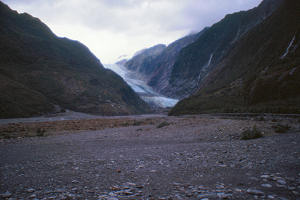
|
| Franz Joseph Glacier |
Anyway, off I went to Franz Joseph and up the side road towards the end of the glacier, passing the two
lasses I’d given a lift yesterday, only there was three of them so I couldn’t have fitted
them in with the junk scattered inside the car. Reached the car park at the end of the road, got out,
took a photograph and the heavens opened. Back into the car, back down the road, did a short detour back
into Franz Joseph where I picked up a couple of hitch-hikers, a Dane and a Swede, and next stop Haast.
The rain let up a bit just north of Haast but we had missed over 100 kilometres of “superb coastal
scenery”. Stopped at the hotel for a beer and then I went down to Jackson’s Bay, the real
end of the West Coast road. Still low cloud and intermittent rain and sandflies. Back up to Haast and on
over the pass. Not an exciting drive in that weather, just plodding on to Wanaka.
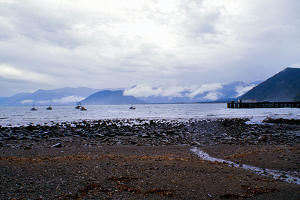
|
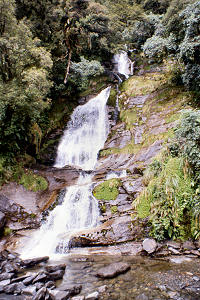
|
Jackson’s Bay
|
Depot Creek Falls, Haast Pass |
When I booked into the hostel, it was almost full of mostly US persons. The weather continued miserable
and an evening confined with that number of North Americans almost drove me to write unkind remarks in
this book, but who knows who might read it so I haven’t.
[ next chapter ]
John Reynolds — March 2013
